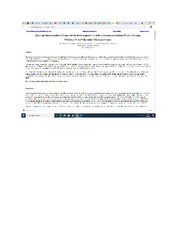| dc.contributor.author | Machete, James | |
| dc.contributor.author | Nsoso, Shalaulani James | |
| dc.contributor.author | Kgwatalala, Patrick | |
| dc.contributor.author | Moreki, John Cassius | |
| dc.contributor.author | Aganga, Andrew | |
| dc.date.accessioned | 2021-07-07T07:50:44Z | |
| dc.date.available | 2021-07-07T07:50:44Z | |
| dc.date.issued | 2017 | |
| dc.identifier.citation | Machete, J. B., Nsoso, S. J., Kgwatalala, P. M., Moreki, J. C., & Aganga, A. O. (2017). Phenotypic characterization of Tswana chickens based on quantitative traits in Kweneng and Southern Districts, Botswana. Livest. Res. Rural Dev, 29. | en_US |
| dc.identifier.issn | 0121-3784 | |
| dc.identifier.uri | https://lrrd.cipav.org.co/lrrd29/7/jmsm29132.html | |
| dc.identifier.uri | http://researchhub.buan.ac.bw:80/handle/123456789/64 | |
| dc.description.abstract | The objective of this study was to characterize both sexes of the naked-neck, dwarf, rumpless, normal-feathered and frizzled strains of Tswana chickens in the Kweneng and Southern districts of Botswana using some quantitative traits. A total of eight (8) quantitative morphological traits such as shank length, shank circumference, spur length, comb length, wattle length, wing length and wingspan were measured using flexible measuring tape, and live body weight was measured using a Spring-Dial Hoist weighing scale.
Data were analyzed using mixed models procedures of SAS and the model included fixed effects of strain and sex and their interaction. Normal-feathered males had significantly higher shank length (9.94±0.23 versus 8.35±0.20), shank circumference (0.99±0.02 versus 0.84±0.02) wing length (20.61±0.51 versus 18.60±0.48), wingspan (41.22±1.03 versus 37.19±0.96), comb length (6.30±0.30 versus 3.48±0.26) and wattle length (3.44±0.16 versus 2.40±0.14) than their female counterparts. Normal-feathered males had the highest live weight and rumpless males had the lowest live weight.
Normal-feathered, naked- neck, frizzled and rumpless females had similar shank length and shank circumference which were all significantly higher than those of their dwarf counterparts. Only naked-neck and normal-feathered females had significantly higher wingspan and wing length than dwarf females. Finally it was noted from this study that various strains of Tswana chickens had the same quantitative traits except for shank length and shank circumference which were significantly smaller in dwarf strain compared to the other four strains. This research work will also play an important role by provision of current information on quantitative traits of Tswana chicken strains. | en_US |
| dc.language.iso | en | en_US |
| dc.publisher | Livestock Research for Rural Development | en_US |
| dc.relation.ispartofseries | Livestock Research for Rural Development;Vol. 29 (7) | |
| dc.subject | Morphological measurements | en_US |
| dc.subject | Quantitative traits | en_US |
| dc.subject | Tswana chickens | en_US |
| dc.title | Phenotypic characterization of Tswana chickens based on quantitative traits in Kweneng and Southern Districts, Botswana | en_US |
| dc.type | Article | en_US |

